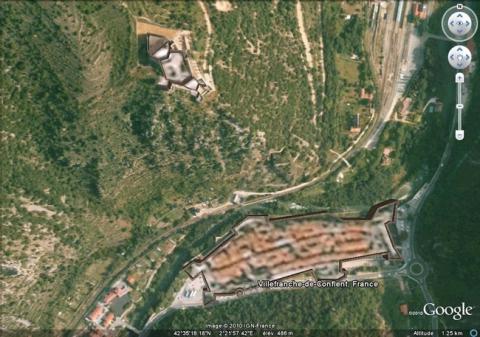Villefranche-de-Conflent
History and description
Situated at the confluent of the Têt and the Cady, in a narrow valley between two mountains, Villefranche-de-Conflent was founded in 1095 by Guillaume Raymond, count of Cerdagne, and vassal of the kingdom of Aragon. Its first urban wall dates back to the 12th century. Its route was similar to that of today, except the eastern part, which faced the valley, and which was rebuilt further forward to extend the town. In the 14th century, the count of Cerdagne, Pierre le Cérémonieux (Pierre the Ceremonious), reinforced the defences by adding semi-circular projection towers. The current tour du Diable is one remaining example. This work allowed Villefranche-de-Conflent to successfully withstand the siege of the Infante Jacques, son of the last King de Majorca, in 1374. Subsequently, the town was besieged multiple times by the French and Spanish until it was finally captured by the French in 1654. The treaty of the Pyrenees from 1659 reinforced this annexing, but from 1655, the French razed three hundred metres of walls and knocked down four of the eight towers of the urban medieval wall in order to make the stronghold indefensible. Only the rampart bordering the Têt was spared.In 1668, after the war of Devolution, the Knight Nicolas de Clerville completed a memoir on the need to fortify Villefranche-de-Conflent to protect the passage of the Pyrenees against which it was constructed. One year later, Vauban laid out his project: it involved reconstructing the ramparts which had been demolished a decade earlier, adding six bastions, two ravelins and an advanced lunette. Two gates, to the west and east, allowed entry. The ravelins were placed in front of each gate. The key point of the project of Vauban was the construction of a fort on a neighbouring area of high ground, the only one from which an enemy would be able to bombard the town. This fort, today known as fort Libéria, was constructed in the form of an irregular polygon, including a glacis and two parade grounds on its northern flank. A covered tunnel with firing ledges for the muskets, the thousand step staircase, connected the fort to the town. The crossing of the Têt was enabled via a bridge protected by a tapered lunette. A firing emplacement covered the confluent of the Têt with the stream of the Cady. Commenced in 1669 and installed by the engineer Saint-Hilaire, the construction was rapidly interrupted by the Revolution of the Angelets. They were only recaptured in 1675 during the war of Holland. The ramparts were completed in 1679, the construction of the fort Libéria commenced in 1680 and was completed in 1682.
Minor constructions were established in fort Libéria in the 19th-20th centuries, but these did not involve any modification to the structure. The upgrading of the casemated cave known as Cova bastéra, planned by Vauban, was completed in the year of his death.
Current state
The fortifications of Villefranche-de-Conflent have been entirely preserved. Disused since the Between-two-wars period, the fortifications have been restored since 1970. All are classed as historical monuments and the site was inscribed on the World Heritage List as part of the fortifications of Vauban. The relief map at a scale of 1/600, constructed in 1701 and repaired in 1776, is on show at the musée des Plans Reliefs (museum of Relief Maps) in Paris. A copy of this map is on show at the local museum.
Villefranche-de-Conflent
Villefranche-de-Conflent
42° 35' 13" N, 2° 21' 59" E
Type
urban wall, fort, casemated cave
Engineers
Jacques de Borelly de Saint-Hilaire, Sébastien le Prestre de Vauban
Department
Pyrénées-Orientales
Region
Occitanie
Bibliography
- AYATS (A.), Les fortifications de Vauban. Découverte guidée en pays catalan, Canet, 2007.
- AYATS (A.), Louis XIV et les Pyrénées catalanes de 1659 à 1681, frontières politiques et frontières militaires, s.l, 2002.
- AYATS (A.), DURBET (G.), « Villefranche-de-Conflent » in Conflent, 1988, n°153.
- BABICS (F.), Commune de Villefranche-de-Conflent, étude d’un plan de rénovation des hameaux et villages, Paris, 2004.
- BABICS (F.), Dossier d’emprise pour le classement par l’UNESCO de Villefranche-de-Conflent au patrimoine mondial de l’humanité, Paris, 2005.
- BERNA- BABONNEAU (L.), « Les fortifications de Villefranche-de-Conflent » in Vauban et ses successeurs dans les Pyrénées, Paris, 2003, p.335-340.
- DURBET (G.), Les remparts de Villefranche-de-Conflent, Villefranche-de-Conflent, 2003.
- FAUCHERRE (N.), La route des fortifications en Méditerranée, Paris, 2007.
- FAUCHERRE (N.), Villefranche-de-Conflent, la sentinelle des Pyrénées, Woippy, 2013.
- WARMOES (I.), Le Musée des Plans-Reliefs, Paris, 1997, p.55.
![Villefranche-de-Conflent, plan de 1693, dans Recueil des plans des environs de plusieurs places du Royaume faits en l’an 1693, [Paris], pl. 42, gallica.bnf.fr / Bibliothèque nationale de France. Villefranche-de-Conflent, plan de 1693, dans Recueil des plans des environs de plusieurs places du Royaume faits en l’an 1693, [Paris], pl. 42, gallica.bnf.fr / Bibliothèque nationale de France.](/sites/default/files/styles/paragraphe_libre/public/images/plan_ancien-93-r270.jpg?itok=N_XgBcFj)
